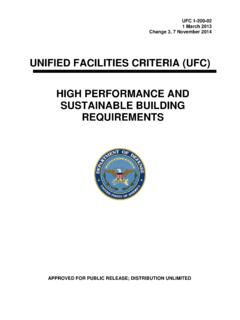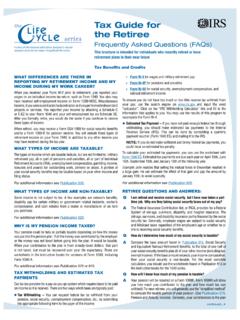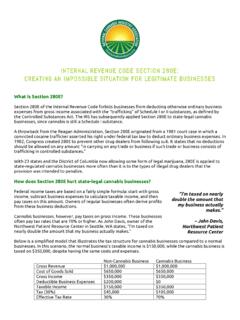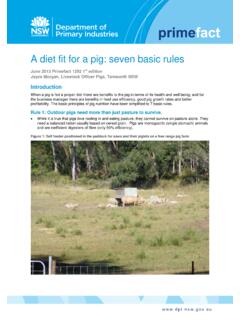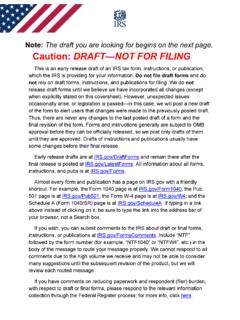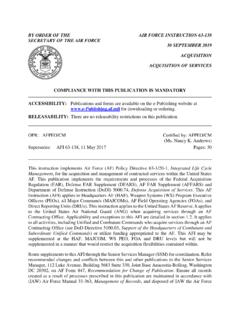Transcription of APR 0 1 2016 ACQUISITION,
1 ACQUISITION, TECHNOLOGY, AND LOGISTIC S OFFICE OF THE UNDER SECRETARY OF DEFENSE 3000 DEFENSE PENTAGON WASHINGTON, DC 20301-3000 APR 0 1 2016 MEMORANDUM FOR COMMANDER, UNITED ST A TES SPECIAL OPERATIONS COMMAND (ATTN: ACQUISITION EXECUTIVE) COMMANDER, UNITED STATES TRANSPORTATION COMMAND (ATTN: ACQUISITION EXECUTIVE) ASSISTANT SECRETARY OF THE ARMY (ACQUISITION, LOGISTICS AND TECHNOLOGY) ASSISTANT SECRETARY OF THE NA VY (RESEARCH, DEVELOPMENT AND ACQUISITION) ASSIST ANT SECRETARY OF THE AIR FORCE (ACQUISITION) GENERAL COUNSEL OF THE DEPARTMENT OF DEFENSE DIRECTORS OF THE DEFENSE AGENCIES DIRECTORS OF THE DOD FIELD ACTIVITIES SUBJECT: Department of Defense Source Selection Procedures This memorandum issues the new Department of Defense Source Selection Procedures (SSP) and rescinds the SSP issued on March 4, 2011, with exceptions noted below.
2 This document expands the discussion of both Tradeoff and Lowest Price Technically Acceptable source selection procedures consistent with Better Buying Power initiatives, modifies evaluation methodologies, updates statutory and regulatory references, and includes best practices obtained through peer reviews. Procedures are posted at and are effective as of the date of this memo. Solicitations with a Source Selection Plan approved by the Source Selection Authority prior to May 1, 2016 may continue to use the procedures dated March 4, 2011. Questions may be directed to Ms. Sara Higgins, at 703-614-1255 or Claire M. Grady Director, Defense Procurement and Acquisition Policy SOURCE SELECTION PROCEDURES DEPARTMENT OF DEFENSE Defense Federal Acquisition Regulation Supplement Procedures, Guidance and Information Subpart Selection March 31, 2016 Intentionally Left Blank i TABLE OF CONTENTS 1 PURPOSE, ROLES, AND RESPONSIBILITIES.
3 1 PURPOSE .. 1 APPLICABILITY AND WAIVERS .. 1 BEST VALUE CONTINUUM .. 2 SOURCE SELECTION TEAM ROLES AND RESPONSIBILITIES .. 5 PRE-SOLICITATION ACTIVITIES .. 17 CONDUCT ACQUISITION PLANNING .. 17 DEVELOP A SOURCE SELECTION PLAN (SSP) .. 18 DEVELOP THE REQUEST FOR PROPOSALS .. 20 RELEASE THE REQUEST FOR PROPOSALS .. 22 EVALUATION AND DECISION 23 EVALUATION ACTIVITIES .. 23 DOCUMENTATION OF INITIAL EVALUATION RESULTS .. 30 AWARD WITHOUT DISCUSSIONS .. 31 COMPETITIVE RANGE DECISION DOCUMENT .. 32 DISCUSSION PROCESS .. 32 FINAL PROPOSAL REVISIONS .. 33 DOCUMENTATION OF FINAL EVALUATION 33 CONDUCT AND DOCUMENT THE COMPARATIVE 34 BEST VALUE DECISION .. 34 SOURCE SELECTION DECISION DOCUMENT .. 35 DEBRIEFINGS .. 36 INTEGRATING PROPOSAL INTO THE CONTRACT .. 36 DOCUMENTATION REQUIREMENTS.
4 37 MINIMUM 37 ELECTRONIC SOURCE SELECTION .. 37 DEFINITIONS .. 38 ii LIST OF TABLES AND FIGURES Table 1. Source Selection Process 3 Figure 1: Typical SST Structure for Solicitations $100M .. 6 Table 2A. Technical Rating Method .. 25 Table 2B. Technical Risk Rating Method .. 25 Table 3. Combined Technical/Risk Rating Method .. 26 Table 4. Past Performance Relevancy Rating 27 Table 5. Performance Confidence Assessments Rating Method .. 29 Table 6. small business Rating Method .. 30 Figure B-1: Subjective Tradeoff Scenario .. B-2 Figure B-2: VATEP Tradeoff Scenario .. B-3 Figure B-3: VATEP Adjustment Example .. B-6 Figure B-4: Value Adjusted Total Evaluated Price Steps .. B-7 Table C-1. Technical Acceptable/Unacceptable Rating Method .. C-2 Table C-2. Past Performance Acceptable/Unacceptable Rating Method.
5 C-3 LIST OF APPENDICES APPENDIX A. DEBRIEFING GUIDE APPENDIX B TRADEOFF SOURCE SELECTION PROCESS: SUBJECTIVE TRADEOFF AND VALUE ADJUSTED TOTAL EVALUATED PRICE (VATEP) TRADEOFF APPENDIX C LOWEST PRICE TECHNICALLY ACCEPTABLE (LPTA) SOURCE SELECTION PROCESS 1 1 Purpose, Roles, and Responsibilities Purpose This document provides the Department of Defense (DoD) procedures for conducting competitively negotiated source selections and outlines a common set of principles and procedures for conducting such acquisitions in accordance with applicable statutes and regulations. The objective of these procedures is to ensure the Department s source selection process delivers quality and timely products and services to the Warfighter and the Nation at the best value to the taxpayer. Source selections should be structured and conducted to communicate the Government s requirements and objectives in clear, meaningful ways to encourage Industry to propose the best possible array of solutions, allow the Government to make meaningful differentiations amongst proposals, and ensure that the award represents the best value to the Warfighter and the Nation.
6 Applicability and Waivers These procedures are applicable to all acquisitions conducted as part of a major s ystem acquisition program, as defined in Federal Acquisition Regulation (FAR) , and all competitively negotiated FAR part 15 acquisitions with an estimated value greater than $10 million. To facilitate uniformity in the source selection process for both Government and Industry, ensure consistent ratings methodology and terminology within the Department, and increase efficiency in workforce training, the following policies supplement existing statute and regulations, unless waived in accordance with paragraph : For acquisitions with a total estimated value greater than or equal to $100 million (including options and/or planned orders), the Agency head shall appoint, in writing, an individual other than the Procuring Contracting Officer (PCO) as the Source Selection Authority (SSA); and the SSA shall establish a Source Selection Advisory Council (SSAC) (see paragraph and ); Source Selection Team (SST) Roles and Responsibilities shall be as described in paragraph.
7 Organizations shall comply with requirements associated with the use of nongovernment Advisors as described in paragraph ; Organizations shall use Rating Methods, Factors, and Descriptions presented in paragraph and Appendix C depending on the type of source selection contemplated and shall consider risk whenever a technical factor is used; SSTs shall develop, maintain, and retain documentation required by Section 4. As guidance, this document also consolidates a number of best practices and notes collected from preaward peer reviews, component reviews, and Program Executive Officer (PEO)/Program Manager (PM) focus group reviews. These procedures are applicable to all competitively negotiated procurements the requirements in paragraph , except those using: 2 Federal Acquisition Regulation (FAR) subpart , Federal Supply Schedules; FAR part 12, Acquisition of Commercial Items, only if FAR part 12 is used solely in conjunction with part 13, Simplified Acquisition Procedures, or part 14, Sealed Bidding; and not used with FAR subpart , Source Selection (see paragraph ); FAR part 13, Simplified Acquisition Procedures; FAR part 14, Sealed Bidding; FAR subpart (b)(1), Orders under multiple award contracts--Fair Opportunity (see also paragraph ); FAR subpart , Broad Agency Announcements; FAR subpart , Architect-Engineer services.
8 And 15 United States Code ( ), Section 638, to solicit and award small business Innovative Research, small business Technology Transfer Research and small business Technology Transfer acquisitions. If FAR subpart , Streamlined Procedures for Evaluation and Solicitation for Items, is used in conjunction with FAR part 15, Contracting by Negotiation, source selection procedures, and not FAR part 13, Simplified Acquisition Procedures, this document shall apply for actions greater than $10 million. Agencies shall consider the use of these procedures for orders under (Fair Opportunity) greater than $10 million. Waivers. For solicitations valued at $1 billion or more, waivers to provisions by paragraph of this document may only be approved with the express, written permission of the Director, Defense Procurement and Acquisition Policy (DPAP).
9 Waivers for solicitations valued below $1 billion must be approved by the Senior Procurement Executive (SPE). The SPE may set lower internal dollar thresholds for use of these procedures as appropriate. For all competitively negotiated acquisitions other than those in paragraph , officers should refer to the procedures in Section 3 and the appendices herein for guidance in structuring a solicitation. Compliance with applicable laws, FAR part 15, Defense Federal Acquisition Supplement (DFARS) part 215, and the companion resource Procedures, Guidance and Information (PGI) is required. Best Value Continuum In the best value continuum described in FAR , an agency can obtain best value in negotiated acquisitions by using any one or a combination of source selection approaches. This document describes source selection processes and some techniques that may be used to design 3 competitive acquisition strategies suitable for the specific circumstances of the acquisition, including: Value Adjusted Total Evaluated Price (VATEP) tradeoff source selection process with monetized adjustments included in the evaluated price for specific enhanced characteristics; tradeoff source selection process with subjective tradeoffs; and lowest price technically acceptable (LPTA) source selection process.
10 These are not the only source selection processes available on the best value continuum. SSTs should carefully consider and use the approach that is most appropriate for their acquisition. At one end of the continuum, LPTA is appropriate where: requirements are well defined; risk of unsuccessful contract performance is minimal; and there is no value, need, or willingness to pay for higher performance. Under LPTA all factors other than cost or price are evaluated on an acceptable or unacceptable basis. The tradeoff source selection process spans the entire remainder of the continuum. Prior to determining the type of source selection appropriate for an acquisition, the Program Manager (PM) or Requirements Owner (RO), as applicable, in consultation with the contracting officer, must consider all aspects of the requirement.


